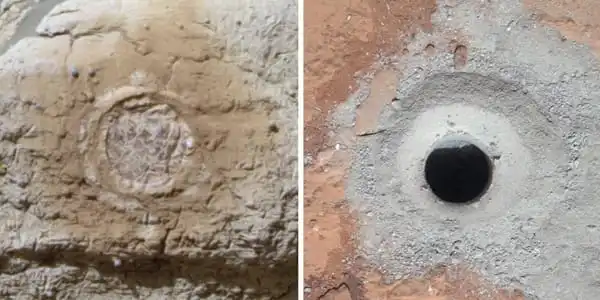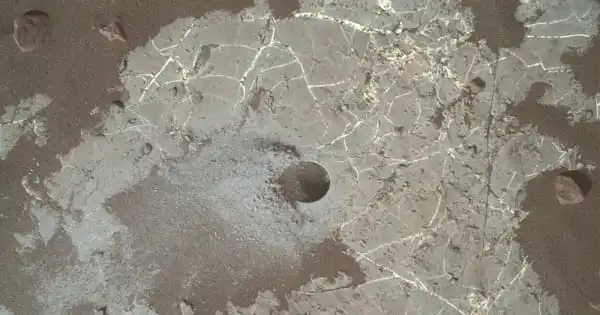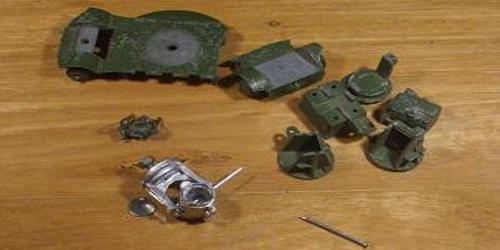Curiosity, NASA’s Mars rover, landed on the Red Planet on August 6, 2012, and has since roamed Gale Crater, collecting samples and sending the results back home for researchers to interpret. Carbon isotope analysis in sediment samples taken from a half-dozen exposed locations, including an exposed cliff, leads researchers to three plausible explanations for the origin of the carbon: cosmic dust, ultraviolet degradation of carbon dioxide, or ultraviolet degradation of biologically produced methane.
“All three of these scenarios are unconventional, unlike processes common on Earth,” the researchers write in Proceedings of the National Academy of Sciences. Carbon is made up of two stable isotopes, 12 and 13. Researchers can determine specifics about the carbon cycle that occurred by looking at the amounts of each in a substance, even if it occurred a very long time ago.
“The amounts of carbon 12 and carbon 13 in our solar system are the amounts that existed at the time of the solar system’s formation,” said Christopher H. House, a Penn State professor of geosciences. “Both are present in everything, but because carbon 12 reacts faster than carbon 13, examining the relative amounts of each in samples can reveal the carbon cycle.”
Curiosity has spent the last nine years exploring an area of Gale Crater that has exposed layers of ancient rock, led by NASA’s Jet Propulsion Laboratory in Southern California. The rover drilled into the layers’ surfaces, recovering samples from buried sedimentary layers. To separate any chemicals, Curiosity heated the samples in the absence of oxygen. A spectrographic analysis of some of the reduced carbon produced by this pyrolysis revealed a wide range of carbon 12 and carbon 13 amounts depending on where or when the original sample was formed. Some carbon samples were exceptionally depleted in carbon 13, whereas others were enriched.
Curiosity has spent the last nine years exploring an area of Gale Crater that has exposed layers of ancient rock. The rover drilled into the layers’ surfaces, recovering samples from buried sedimentary layers.
Christopher H. House
“The samples that are extremely depleted in carbon 13 are similar to samples from Australia taken from sediment that is 2.7 billion years old,” House said. “Those samples were caused by biological activity when methane was consumed by ancient microbial mats, but we can’t say the same for Mars because it could have formed from different materials and processes than Earth.”
The researchers propose three explanations for the exceptionally depleted samples: a cosmic dust cloud, ultraviolet radiation breaking down carbon dioxide, or ultraviolet degradation of biologically created methane.
According to House, the solar system passes through a galactic molecular cloud every couple of hundred million years. “It doesn’t leave a lot of dust,” House said. “It’s difficult to find any of these deposition events in the Earth’s record.”
The galactic dust cloud would have first lowered the temperature of a Mars that still had water and created glaciers to create a layer that Curiosity could sample. The dust would have accumulated on top of the ice and would have had to remain in place once the glacier melted, leaving behind a layer of dirt containing carbon. So far, there is little evidence of past glaciers in Mars’ Gale Crater. “This explanation is plausible,” the researchers write, “but it requires additional research.”

The ultraviolet conversion of carbon dioxide to organic compounds such as formaldehyde is another possible explanation for lower levels of carbon 13. “There are papers that predict UV could cause this type of fractionation,” House said. “However, more experimental results demonstrating this size fractionation are required before we can rule in or rule out this explanation.” The biological basis underpins the third possible method of producing carbon 13 depleted samples.
A strongly carbon 13 depleted signature from a paleosurface on Earth would indicate that microbially produced methane was consumed by past microbes. Large plumes of methane may have been released from the subsurface of ancient Mars, where methane production would have been energetically favorable. The methane would then be consumed by surface microbes or react with ultraviolet light and be deposited directly on the surface.
However, because there is no sedimentary evidence of surface microbes on the past Mars landscape, the biological explanation highlighted in the paper relies on ultraviolet light to place the carbon 13 signal on the ground, according to the researchers.
“All three possibilities point to an unusual carbon cycle unlike anything seen on Earth today,” House explained. “However, more data is required to determine which of these explanations is correct. It would be ideal if the rover could detect a large methane plume and measure the carbon isotopes in it, but most methane plumes are small, and no rover has sampled one large enough to measure the isotopes.”
House also mentions that finding the remains of microbial mats or evidence of glacial deposits may help to clear things up a little. “We’re being cautious in our interpretation, which is the best course of action when studying another world,” House explained. Curiosity is still collecting and analyzing samples, and it will return to the pediment where some of the samples in this study were discovered in about a month.
“This research achieved a long-standing goal for Mars exploration,” House said. “It looks at 9 years of exploration to measure different carbon isotopes – one of the most important geology tools – from sediment on another habitable world.”
















